Measurement of multidifferential cross sections for dijet production in proton-proton collisions at
- PMID: 39873299
- PMCID: PMC11761505
- DOI: 10.1140/epjc/s10052-024-13606-8
Measurement of multidifferential cross sections for dijet production in proton-proton collisions at
Abstract
A measurement of the dijet production cross section is reported based on proton-proton collision data collected in 2016 at by the CMS experiment at the CERN LHC, corresponding to an integrated luminosity of up to 36.3 . Jets are reconstructed with the anti- algorithm for distance parameters of and 0.8. Cross sections are measured double-differentially (2D) as a function of the largest absolute rapidity of the two jets with the highest transverse momenta and their invariant mass , and triple-differentially (3D) as a function of the rapidity separation , the total boost , and either or the average of the two jets. The cross sections are unfolded to correct for detector effects and are compared with fixed-order calculations derived at next-to-next-to-leading order in perturbative quantum chromodynamics. The impact of the measurements on the parton distribution functions and the strong coupling constant at the mass of the boson is investigated, yielding a value of .
© The Author(s) 2024.
Conflict of interest statement
Conflict of interestThe authors declare that they have no Conflict of interest.
Figures









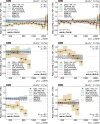
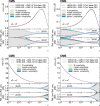


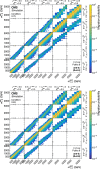





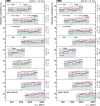

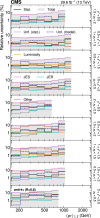
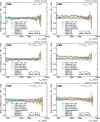


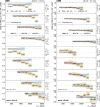

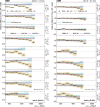
Similar articles
-
Measurement of the triple-differential dijet cross section in proton-proton collisions at and constraints on parton distribution functions.Eur Phys J C Part Fields. 2017;77(11):746. doi: 10.1140/epjc/s10052-017-5286-7. Epub 2017 Nov 7. Eur Phys J C Part Fields. 2017. PMID: 31999281 Free PMC article.
-
Measurement of differential cross sections for boson production in association with jets in proton-proton collisions at .Eur Phys J C Part Fields. 2018;78(11):965. doi: 10.1140/epjc/s10052-018-6373-0. Epub 2018 Nov 22. Eur Phys J C Part Fields. 2018. PMID: 30881214 Free PMC article.
-
Measurement of the [Formula: see text] dijet cross section in pp collisions at [Formula: see text] TeV with the ATLAS detector.Eur Phys J C Part Fields. 2016;76(12):670. doi: 10.1140/epjc/s10052-016-4521-y. Epub 2016 Dec 5. Eur Phys J C Part Fields. 2016. PMID: 28316501 Free PMC article.
-
Measurement of multijet azimuthal correlations and determination of the strong coupling in proton-proton collisions at .Eur Phys J C Part Fields. 2024;84(8):842. doi: 10.1140/epjc/s10052-024-13116-7. Epub 2024 Aug 21. Eur Phys J C Part Fields. 2024. PMID: 39185726 Free PMC article.
-
Measurement of differential cross sections and charge ratios for t-channel single top quark production in proton-proton collisions at .Eur Phys J C Part Fields. 2020;80(5):370. doi: 10.1140/epjc/s10052-020-7858-1. Epub 2020 May 6. Eur Phys J C Part Fields. 2020. PMID: 32633732 Free PMC article.
Cited by
-
Study of trijet production in proton-proton collisions at different energies.Sci Rep. 2025 Jul 22;15(1):26670. doi: 10.1038/s41598-025-11867-1. Sci Rep. 2025. PMID: 40695998 Free PMC article.
References
-
-
H1 and ZEUS Collaborations, Combined measurement and QCD analysis of the inclusive
 scattering cross sections at HERA. JHEP 01, 109 (2010). 10.1007/JHEP01(2010)109. arXiv:0911.0884
scattering cross sections at HERA. JHEP 01, 109 (2010). 10.1007/JHEP01(2010)109. arXiv:0911.0884
-
H1 and ZEUS Collaborations, Combined measurement and QCD analysis of the inclusive
-
-
H1 and ZEUS Collaborations, Combination of measurements of inclusive deep inelastic
 scattering cross sections and QCD analysis of HERA data. Eur. Phys. J. C 75, 580 (2015). 10.1140/epjc/s10052-015-3710-4. arXiv:1506.06042
scattering cross sections and QCD analysis of HERA data. Eur. Phys. J. C 75, 580 (2015). 10.1140/epjc/s10052-015-3710-4. arXiv:1506.06042
-
H1 and ZEUS Collaborations, Combination of measurements of inclusive deep inelastic
-
- J. Currie et al., Precise predictions for dijet production at the LHC. Phys. Rev. Lett. 119, 152001 (2017). 10.1103/PhysRevLett.119.152001. arXiv:1705.10271 - PubMed
-
- A. Gehrmann-De Ridder et al., Triple differential dijet cross section at the LHC. Phys. Rev. Lett. 123, 102001 (2019). 10.1103/PhysRevLett.123.102001. arXiv:1905.09047 - PubMed
-
-
CMS Collaboration, Measurement of the triple-differential dijet cross section in proton-proton collisions at
 and constraints on parton distribution functions. Eur. Phys. J. C 77, 746 (2017). 10.1140/epjc/s10052-017-5286-7. arXiv:1705.02628
-
PMC
-
PubMed
and constraints on parton distribution functions. Eur. Phys. J. C 77, 746 (2017). 10.1140/epjc/s10052-017-5286-7. arXiv:1705.02628
-
PMC
-
PubMed
-
CMS Collaboration, Measurement of the triple-differential dijet cross section in proton-proton collisions at
LinkOut - more resources
Full Text Sources
